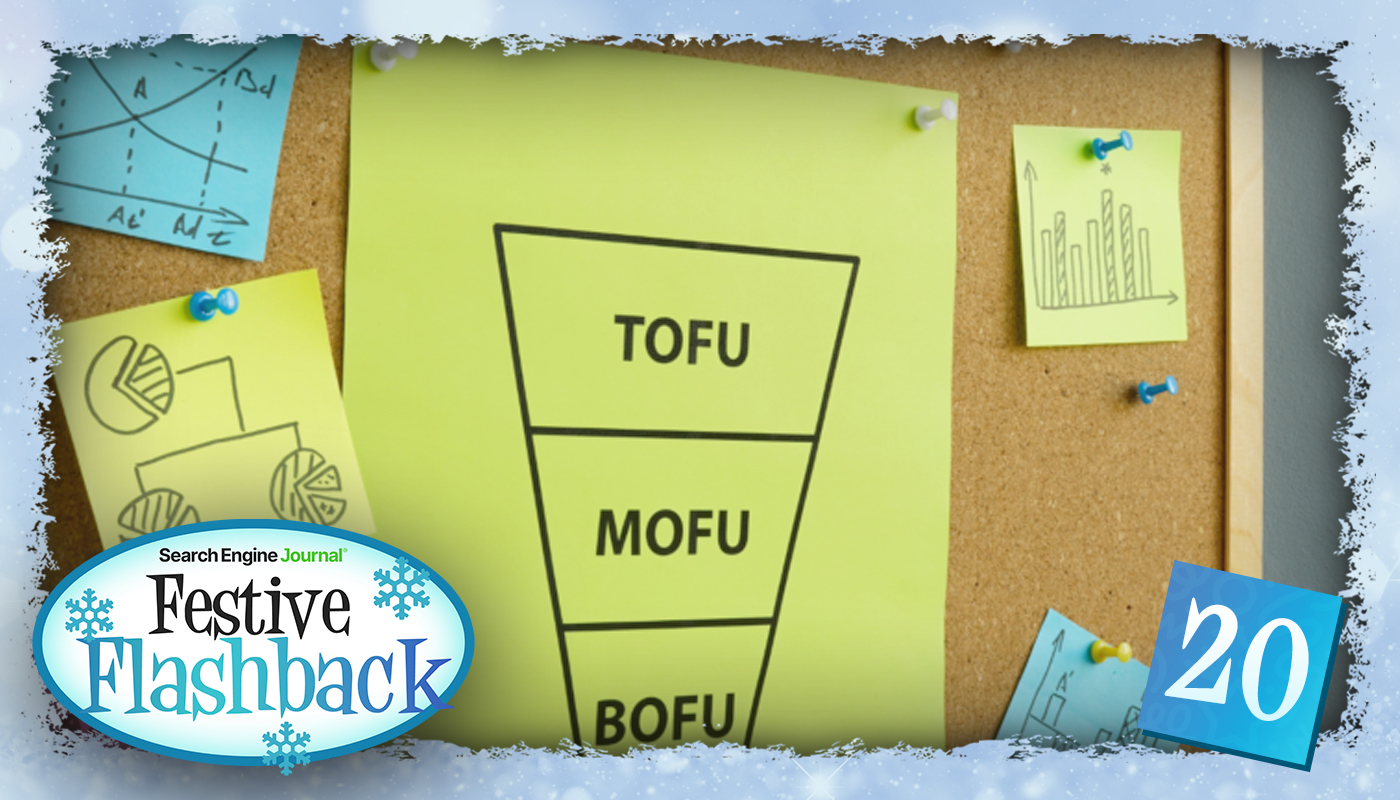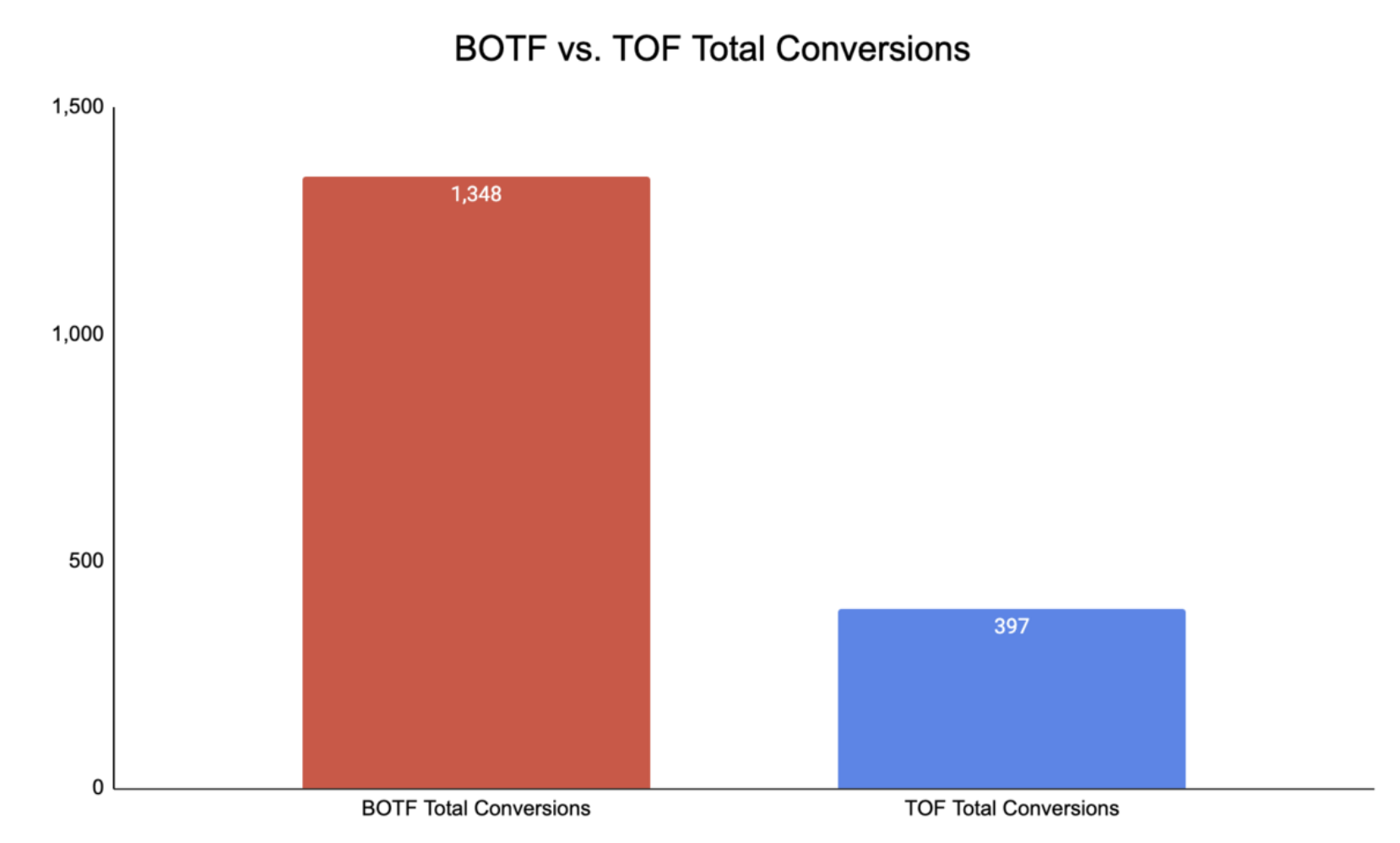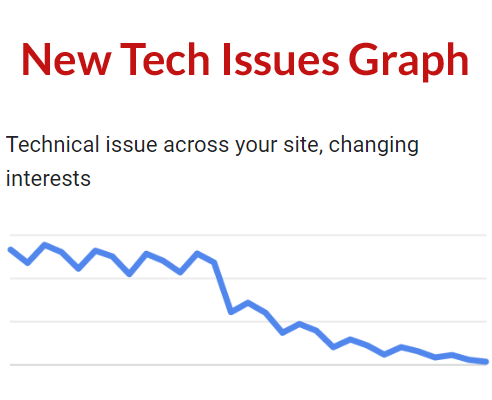SEO
Why Brands Should Prioritize Bottom Of Funnel Keywords In SEO

Celebrate the Holidays with some of SEJ’s best articles of 2023.
Our Festive Flashback series runs from December 21 – January 5, featuring daily reads on significant events, fundamentals, actionable strategies, and thought leader opinions.
2023 has been quite eventful in the SEO industry and our contributors produced some outstanding articles to keep pace and reflect these changes.
Catch up on the best reads of 2023 to give you plenty to reflect on as you move into 2024.
The concept of search intent and the recommendation that marketers pay close attention to it when targeting organic keywords is well established in SEO.
But while a lot of SEO writing has described search intent (for example, these two excellent articles on SEJ on creating content that satisfies search intent and understanding how people search), most stop short of clearly prescribing how brands should prioritize keywords.
Specifically, most discussions of search intent state the fact that search queries range from informational (people looking to learn about a topic), to comparative (people comparing solutions to their problem), to transactional (people looking to buy).
This is often visualized as a marketing funnel.
But regarding recommendations on how to use search intent to your advantage in SEO, the most common advice is to ensure you have a variety of content to “cover” the full spectrum of search intent; have some informational, some mid-funnel, and some transactional content.
We disagree.
Specifically, we’ve found in working with dozens of brands over many years in creating SEO-focused content that the vast majority of companies should not create an even spread of content across the funnel, but rather prioritize bottom of funnel content and slowly work their way up.
Why?
Because SEO resources are finite and bottom of funnel content (e.g., search queries with “transactional” search intent) generates tremendously more return on investment (ROI) on SEO spend than everything else.
In this article, we’ll explain our reasoning and share data supporting this thesis.
SEO Resources Are Finite: You Can’t Target All Keywords Well
The general recommendation that you should “make sure you have content for all stages of the funnel” (aka all search intents) would be fine if companies had infinite SEO resources – meaning unlimited writers to produce content, unlimited SEO strategists to pick keywords and do SERP analysis, and unlimited budget for link building.
But no brand has this.
Even the idea of AI-assisted writing making producing massive amounts of content easier doesn’t negate this fact.
Sure, AI tools can produce thousands of pieces in a fraction of the time it would take a human, but that doesn’t mean they will all rank or be good enough to impress prospective customers and convert.
If a bunch of sites are all producing similar AI-assisted content to target the same keywords, Google will have to differentiate somehow to decide who to rank – and two safe bets in how it will make this decision are content quality and backlinks.
In terms of content quality, it’s quite likely that the best pieces for a given keyword will be the ones with the most originality and specific personal expertise, traits that Google has clearly stated it prefers and which require human input.
And backlinks have been a known ranking factor forever in SEO. In a world where many sites produce similar AI-produced pieces targeting the same keywords, it’s safe to assume it will be just as, if not more, important.
So regardless of how content is produced, SEO resources for everyone are finite. There are a finite number of employee hours, a finite number of writing budgets (regardless of if writers use AI), and a finite link building budget.
That means you have to prioritize the keywords you will target.
And the most logical way to prioritize is to focus SEO efforts on whatever will generate the most ROI (that is, leads and sales attributable to SEO).
In our experience, that is bottom of funnel, transactional, keywords.
Bottom Of Funnel Keywords Convert Significantly More Than Everything Else
To conclude, as we have, that bottom of funnel content converts significantly more than any other type of content, the first step is to actually measure and track conversions from SEO.
This sounds obvious, but the reality is that most SEO and content teams don’t do this; they just assume the more traffic, the better, and their entire strategy is focused on growing traffic.
You can measure conversion from SEO in different ways via different analytics tools, but in general, the process will require the following steps:
- Define a conversion. This is typically a lead form fill or trial start for SaaS or sales-based businesses, or an actual transaction for ecommerce businesses.
- Create a goal in your analytics platform to measure this conversion event.
- Generate reports of which landing pages on your site resulted in how many conversions. This can be done via different attribution models like first or last click, depending on the analytics platform, but any data here is better than no data.
When you do this, you’ll inevitably find what we have found over 5+ years, dozens of brands, and hundreds of SEO pieces.
Specifically, pages on your site that rank for bottom of funnel keywords convert at multiple single digit percent (1% – 5%), whereas pages that rank for top of funnel, informational keywords typically convert at a fraction of a percent (0.01% – 0.5%).
In other words, the difference in conversion rate between bottom and top of funnel keywords is not 10%, 20%, or even 50% – it’s multiple fold.
This is exemplified in this data across 60+ content pieces for a software client of ours, where the content ranking for bottom of funnel queries converted on average at 25X higher than articles that targeted mid to top of funnel queries.

Bottom of funnel posts had a 4.78% conversion rate versus 0.19% for top of funnel posts. Based on 60+ posts for a client.
Even after accounting for top of funnel pieces getting more traffic, the raw conversions from just 20 bottom of funnel pieces were 3 times more than those from 40 top of funnel pieces:
 Image created by author, June 2023
Image created by author, June 2023
20 bottom of funnel posts generated 1348 conversions while 40 top of funnel posts generated 397 conversions.
To emphasize, the 1350 conversions from BOTF content above are from only 22 pieces, whereas the 400 conversions from TOF are from 42 articles.
In addition, we should mention the articles we labeled as “top of funnel” in this study still had some buying intent. We went after them only after exhausting most bottom of funnel keywords and chose the keywords strategically to ensure they still had some chance of a conversion.
In that respect it’s fair even to call them “mid-funnel.” For many companies, the majority of their content and SEO efforts are directed exclusively at top of funnel keywords that will convert to leads or sales at or below the conversion rates above.
That’s a tragic waste of SEO efforts, in our minds.
Why Are Informational, Top Of Funnel Keywords So Low Converting?
The argument for chasing top of funnel keywords is typically that their search volumes are high.
So, the story goes, you can get your brand in front of a large number of people who, at some point in the future, are likely to need a product or service like yours.
But as the data above shows, and our collective experience confirms, it requires so many steps to get to a conversion from top of funnel traffic that the conversion rates are minuscule.
Specifically, the journey from someone Googling a top of funnel informational query to becoming a customer is:
- They Google the query.
- They click into your results.
- They read the article.
- Some fraction of these users either return to your site on pure memory or give their email to download a white paper or gated resource.
- Some fraction of those users open subsequent drip emails.
- Then at some point, some fraction of those users will need your product or service and reach out.
Each of these steps has a small conversion rate, so in combination, the entire journey has an absolutely minuscule conversion rate.
So much so that, as per the data above, a possibly higher search volume of these top of funnel queries compared to transactional queries does not make up for the tiny conversion rates.
There Are More Bottom Of Funnel Keywords Than You Think
So if you buy into this notion that targeting bottom of the funnel keywords is a better use of finite SEO resources than evenly spreading SEO content across the full spectrum of search intent, the next important question to tackle is: “Which keywords in my space are bottom of the funnel are high converting and how many of them are there?”
We’ve noticed that many SEO pros and marketers have a limited view of which keywords are bottom of funnel – that is, have some level of transaction or buying intent.
In our experience, there are three common buckets of bottom of funnel keywords, only the first of which is commonly considered as bottom of funnel.
1. Category Keywords
If we use a hypothetical business that we’re all familiar with, SEO software, the obvious transactional keywords are things like “SEO software” or “best SEO tools.”
Yes, those are very high-converting bottom of the funnel or transactional keywords that any SEO software brand should absolutely target.
In our framework for BOTF SEO, called Pain Point SEO, we call these “category keywords” since they involve the user literally Googling the name of the product or service category.
Most SEO and marketing teams are aware of these keywords and do target them, usually with the homepage or one or two landing pages.
But what we’ve found is that many teams consider this to be the entirety of bottom of funnel or transactional keywords. They target a few category keywords and spend the rest of their time creating blog content to rank for top of funnel search terms.
But there are actually a lot of other high-converting search terms that we notice most brands don’t think about and ignore in favor of producing content to go after extremely low converting top of funnel keywords.
2. Comparison Keywords
Specifically, another extremely high-converting category of keywords is what we call comparison keywords.
These are keywords that show the searcher is comparing multiple options, such as “salesforce vs pipedrive” or “adidas vs nike womens running shoes.”
Many discussions of search intent categorize this as a mid-funnel query because, they say, the searcher may not be ready to make a transaction but is simply doing product research.
But in our measurements of conversion rates of hundreds of pages ranking for comparison keywords, they often convert just as high as the category keywords discussed above.
As a result, in my view, companies that want to maximize ROI from SEO should aggressively target comparison keywords.
They should identify every comparison keyword stemming from their top competitors that has any semblance of search volume and ensure they have a dedicated page on their site to rank for each.
3. Jobs To Be Done Keywords
The final of our three categories of keywords that we have found can generate conversions from SEO are jobs to be done keywords.
This is the largest of these three categories of high-buying-intent keywords, meaning there are usually a lot more jobs to be done keywords than category or comparison.
This category is often ignored or not prioritized by brands as being conversion-generating, though, because these are queries where the user is not overtly looking for or comparing product options but is indicating that they have a problem that your product happens to solve.
In our SEO software example, this would include queries like “how to do competitor keyword research,” “how to know search volume of keywords,” or “how to track which keywords a site ranks for.”
If you have an SEO software product with features that lets people do those things, then, in our experience, ranking for keywords like these will generate conversions.
Typically the conversion rate of these keywords is slightly lower than category or comparison keywords.
However, they are still much better than top of funnel queries like “SEO strategy,” “best SEO tips,” or even “digital marketing strategies,” which are typical top of funnel keywords companies go after but which have very little buying intent.
More resources:
Featured Image: Vitalii Vodolazskyi/Shutterstock
SEO
Big Update To Google’s Ranking Drop Documentation

Google updated their guidance with five changes on how to debug ranking drops. The new version contains over 400 more words that address small and large ranking drops. There’s room to quibble about some of the changes but overall the revised version is a step up from what it replaced.
Change# 1: Downplays Fixing Traffic Drops
The opening sentence was changed so that it offers less hope for bouncing back from an algorithmic traffic drop. Google also joined two sentences into one sentence in the revised version of the documentation.
The documentation previously said that most traffic drops can be reversed and that identifying the reasons for a drop aren’t straightforward. The part about most of them can be reversed was completely removed.
Here is the original two sentences:
“A drop in organic Search traffic can happen for several reasons, and most of them can be reversed. It may not be straightforward to understand what exactly happened to your site”
Now there’s no hope offered for “most of them can be reversed” and more emphasis on understanding what happened is not straightforward.
This is the new guidance
“A drop in organic Search traffic can happen for several reasons, and it may not be straightforward to understand what exactly happened to your site.”
Change #2 Security Or Spam Issues
Google updated the traffic graph illustrations so that they precisely align with the causes for each kind of traffic decline.
The previous version of the graph was labeled:
“Site-level technical issue (Manual Action, strong algorithmic changes)”
The problem with the previous label is that manual actions and strong algorithmic changes are not technical issues and the new version fixes that issue.
The updated version now reads:
“Large drop from an algorithmic update, site-wide security or spam issue”
Change #3 Technical Issues
There’s one more change to a graph label, also to make it more accurate.
This is how the previous graph was labeled:
“Page-level technical issue (algorithmic changes, market disruption)”
The updated graph is now labeled:
“Technical issue across your site, changing interests”
Now the graph and label are more specific as a sitewide change and “changing interests” is more general and covers a wider range of changes than market disruption. Changing interests includes market disruption (where a new product makes a previous one obsolete or less desirable) but it also includes products that go out of style or loses their trendiness.

Change #4 Google Adds New Guidance For Algorithmic Changes
The biggest change by far is their brand new section for algorithmic changes which replaces two smaller sections, one about policy violations and manual actions and a second one about algorithm changes.
The old version of this one section had 108 words. The updated version contains 443 words.
A section that’s particularly helpful is where the guidance splits algorithmic update damage into two categories.
Two New Categories:
- Small drop in position? For example, dropping from position 2 to 4.
- Large drop in position? For example, dropping from position 4 to 29.
The two new categories are perfect and align with what I’ve seen in the search results for sites that have lost rankings. The reasons for dropping up and down within the top ten are different from the reasons why a site drops completely out of the top ten.
I don’t agree with the guidance for large drops. They recommend reviewing your site for large drops, which is good advice for some sites that have lost rankings. But in other cases there’s nothing wrong with the site and this is where less experienced SEOs tend to be unable to fix the problems because there’s nothing wrong with the site. Recommendations for improving EEAT, adding author bios or filing link disavows do not solve what’s going on because there’s nothing wrong with the site. The problem is something else in some of the cases.
Here is the new guidance for debugging search position drops:
“Algorithmic update
Google is always improving how it assesses content and updating its search ranking and serving algorithms accordingly; core updates and other smaller updates may change how some pages perform in Google Search results. We post about notable improvements to our systems on our list of ranking updates page; check it to see if there’s anything that’s applicable to your site.If you suspect a drop in traffic is due to an algorithmic update, it’s important to understand that there might not be anything fundamentally wrong with your content. To determine whether you need to make a change, review your top pages in Search Console and assess how they were ranking:
Small drop in position? For example, dropping from position 2 to 4.
Large drop in position? For example, dropping from position 4 to 29.Keep in mind that positions aren’t static or fixed in place. Google’s search results are dynamic in nature because the open web itself is constantly changing with new and updated content. This constant change can cause both gains and drops in organic Search traffic.
Small drop in position
A small drop in position is when there’s a small shift in position in the top results (for example, dropping from position 2 to 4 for a search query). In Search Console, you might see a noticeable drop in traffic without a big change in impressions.Small fluctuations in position can happen at any time (including moving back up in position, without you needing to do anything). In fact, we recommend avoiding making radical changes if your page is already performing well.
Large drop in position
A large drop in position is when you see a notable drop out of the top results for a wide range of terms (for example, dropping from the top 10 results to position 29).In cases like this, self-assess your whole website overall (not just individual pages) to make sure it’s helpful, reliable and people-first. If you’ve made changes to your site, it may take time to see an effect: some changes can take effect in a few days, while others could take several months. For example, it may take months before our systems determine that a site is now producing helpful content in the long term. In general, you’ll likely want to wait a few weeks to analyze your site in Search Console again to see if your efforts had a beneficial effect on ranking position.
Keep in mind that there’s no guarantee that changes you make to your website will result in noticeable impact in search results. If there’s more deserving content, it will continue to rank well with our systems.”
Change #5 Trivial Changes
The rest of the changes are relatively trivial but nonetheless makes the documentation more precise.
For example, one of the headings was changed from this:
You recently moved your site
To this new heading:
Site moves and migrations
Google’s Updated Ranking Drops Documentation
Google’s updated documentation is a well thought out but I think that the recommendations for large algorithmic drops are helpful for some cases and not helpful for other cases. I have 25 years of SEO experience and have experienced every single Google algorithm update. There are certain updates where the problem is not solved by trying to fix things and Google’s guidance used to be that sometimes there’s nothing to fix. The documentation is better but in my opinion it can be improved even further.
Read the new documentation here:
Debugging drops in Google Search traffic
Review the previous documentation:
Internet Archive Wayback Machine: Debugging drops in Google Search traffic
Featured Image by Shutterstock/Tomacco
SEO
Google March 2024 Core Update Officially Completed A Week Ago

Google has officially completed its March 2024 Core Update, ending over a month of ranking volatility across the web.
However, Google didn’t confirm the rollout’s conclusion on its data anomaly page until April 26—a whole week after the update was completed on April 19.
Many in the SEO community had been speculating for days about whether the turbulent update had wrapped up.
The delayed transparency exemplifies Google’s communication issues with publishers and the need for clarity during core updates
Google March 2024 Core Update Timeline & Status
First announced on March 5, the core algorithm update is complete as of April 19. It took 45 days to complete.
Unlike more routine core refreshes, Google warned this one was more complex.
Google’s documentation reads:
“As this is a complex update, the rollout may take up to a month. It’s likely there will be more fluctuations in rankings than with a regular core update, as different systems get fully updated and reinforce each other.”
The aftershocks were tangible, with some websites reporting losses of over 60% of their organic search traffic, according to data from industry observers.
The ripple effects also led to the deindexing of hundreds of sites that were allegedly violating Google’s guidelines.
Addressing Manipulation Attempts
In its official guidance, Google highlighted the criteria it looks for when targeting link spam and manipulation attempts:
- Creating “low-value content” purely to garner manipulative links and inflate rankings.
- Links intended to boost sites’ rankings artificially, including manipulative outgoing links.
- The “repurposing” of expired domains with radically different content to game search visibility.
The updated guidelines warn:
“Any links that are intended to manipulate rankings in Google Search results may be considered link spam. This includes any behavior that manipulates links to your site or outgoing links from your site.”
John Mueller, a Search Advocate at Google, responded to the turbulence by advising publishers not to make rash changes while the core update was ongoing.
However, he suggested sites could proactively fix issues like unnatural paid links.
“If you have noticed things that are worth improving on your site, I’d go ahead and get things done. The idea is not to make changes just for search engines, right? Your users will be happy if you can make things better even if search engines haven’t updated their view of your site yet.”
Emphasizing Quality Over Links
The core update made notable changes to how Google ranks websites.
Most significantly, Google reduced the importance of links in determining a website’s ranking.
In contrast to the description of links as “an important factor in determining relevancy,” Google’s updated spam policies stripped away the “important” designation, simply calling links “a factor.”
This change aligns with Google’s Gary Illyes’ statements that links aren’t among the top three most influential ranking signals.
Instead, Google is giving more weight to quality, credibility, and substantive content.
Consequently, long-running campaigns favoring low-quality link acquisition and keyword optimizations have been demoted.
With the update complete, SEOs and publishers are left to audit their strategies and websites to ensure alignment with Google’s new perspective on ranking.
Core Update Feedback
Google has opened a ranking feedback form related to this core update.
You can use this form until May 31 to provide feedback to Google’s Search team about any issues noticed after the core update.
While the feedback provided won’t be used to make changes for specific queries or websites, Google says it may help inform general improvements to its search ranking systems for future updates.
Google also updated its help documentation on “Debugging drops in Google Search traffic” to help people understand ranking changes after a core update.
Featured Image: Rohit-Tripathi/Shutterstock
FAQ
After the update, what steps should websites take to align with Google’s new ranking criteria?
After Google’s March 2024 Core Update, websites should:
- Improve the quality, trustworthiness, and depth of their website content.
- Stop heavily focusing on getting as many links as possible and prioritize relevant, high-quality links instead.
- Fix any shady or spam-like SEO tactics on their sites.
- Carefully review their SEO strategies to ensure they follow Google’s new guidelines.
SEO
Google Declares It The “Gemini Era” As Revenue Grows 15%

Alphabet Inc., Google’s parent company, announced its first quarter 2024 financial results today.
While Google reported double-digit growth in key revenue areas, the focus was on its AI developments, dubbed the “Gemini era” by CEO Sundar Pichai.
The Numbers: 15% Revenue Growth, Operating Margins Expand
Alphabet reported Q1 revenues of $80.5 billion, a 15% increase year-over-year, exceeding Wall Street’s projections.
Net income was $23.7 billion, with diluted earnings per share of $1.89. Operating margins expanded to 32%, up from 25% in the prior year.
Ruth Porat, Alphabet’s President and CFO, stated:
“Our strong financial results reflect revenue strength across the company and ongoing efforts to durably reengineer our cost base.”
Google’s core advertising units, such as Search and YouTube, drove growth. Google advertising revenues hit $61.7 billion for the quarter.
The Cloud division also maintained momentum, with revenues of $9.6 billion, up 28% year-over-year.
Pichai highlighted that YouTube and Cloud are expected to exit 2024 at a combined $100 billion annual revenue run rate.
Generative AI Integration in Search
Google experimented with AI-powered features in Search Labs before recently introducing AI overviews into the main search results page.
Regarding the gradual rollout, Pichai states:
“We are being measured in how we do this, focusing on areas where gen AI can improve the Search experience, while also prioritizing traffic to websites and merchants.”
Pichai reports that Google’s generative AI features have answered over a billion queries already:
“We’ve already served billions of queries with our generative AI features. It’s enabling people to access new information, to ask questions in new ways, and to ask more complex questions.”
Google reports increased Search usage and user satisfaction among those interacting with the new AI overview results.
The company also highlighted its “Circle to Search” feature on Android, which allows users to circle objects on their screen or in videos to get instant AI-powered answers via Google Lens.
Reorganizing For The “Gemini Era”
As part of the AI roadmap, Alphabet is consolidating all teams building AI models under the Google DeepMind umbrella.
Pichai revealed that, through hardware and software improvements, the company has reduced machine costs associated with its generative AI search results by 80% over the past year.
He states:
“Our data centers are some of the most high-performing, secure, reliable and efficient in the world. We’ve developed new AI models and algorithms that are more than one hundred times more efficient than they were 18 months ago.
How Will Google Make Money With AI?
Alphabet sees opportunities to monetize AI through its advertising products, Cloud offerings, and subscription services.
Google is integrating Gemini into ad products like Performance Max. The company’s Cloud division is bringing “the best of Google AI” to enterprise customers worldwide.
Google One, the company’s subscription service, surpassed 100 million paid subscribers in Q1 and introduced a new premium plan featuring advanced generative AI capabilities powered by Gemini models.
Future Outlook
Pichai outlined six key advantages positioning Alphabet to lead the “next wave of AI innovation”:
- Research leadership in AI breakthroughs like the multimodal Gemini model
- Robust AI infrastructure and custom TPU chips
- Integrating generative AI into Search to enhance the user experience
- A global product footprint reaching billions
- Streamlined teams and improved execution velocity
- Multiple revenue streams to monetize AI through advertising and cloud
With upcoming events like Google I/O and Google Marketing Live, the company is expected to share further updates on its AI initiatives and product roadmap.
Featured Image: Sergei Elagin/Shutterstock
-

 MARKETING7 days ago
MARKETING7 days agoAdvertising in local markets: A playbook for success
-

 SEARCHENGINES7 days ago
SEARCHENGINES7 days agoGoogle Core Update Flux, AdSense Ad Intent, California Link Tax & More
-

 SEARCHENGINES6 days ago
SEARCHENGINES6 days agoGoogle Needs Very Few Links To Rank Pages; Links Are Less Important
-

 SEO5 days ago
SEO5 days agoHow to Become an SEO Lead (10 Tips That Advanced My Career)
-

 PPC5 days ago
PPC5 days ago10 Most Effective Franchise Marketing Strategies
-

 MARKETING6 days ago
MARKETING6 days agoHow to Use AI For a More Effective Social Media Strategy, According to Ross Simmonds
-

 PPC6 days ago
PPC6 days agoBiggest Trends, Challenges, & Strategies for Success
-

 SEARCHENGINES3 days ago
SEARCHENGINES3 days agoGoogle Won’t Change The 301 Signals For Ranking & SEO










![The Current State of Google’s Search Generative Experience [What It Means for SEO in 2024] person typing on laptop with](https://articles.entireweb.com/wp-content/uploads/2024/04/The-Current-State-of-Googles-Search-Generative-Experience-What-It.webp-400x240.webp)
![The Current State of Google’s Search Generative Experience [What It Means for SEO in 2024] person typing on laptop with](https://articles.entireweb.com/wp-content/uploads/2024/04/The-Current-State-of-Googles-Search-Generative-Experience-What-It.webp-80x80.webp)



